With the incredible ballooning of the plant-based milk market of the last few years, one could be forgiven for thinking it’s a modern oddity, but soy and almond milk have been made in Asia and the Middle East for centuries. Mexico’s famous cinnamon-spiked rice drink, horchata, has been around for hundreds of years as well. Still, as the incidence of allergies increases and interest in sustainable, vegan and plant-based diets rises, the options have mushroomed — or rather, they’ve hemped, cashewed and legumed. They’ve come a long way from the hauntingly translucent, watery and nutrient-bare rice milk of the '90s, too. Many of them now on the market are excellent in flavor, texture and nutritional punch.
Dairy-free cheese, though, has historically been much harder to nail down. In chemistry terms, the difficulty of replicating the special properties of real dairy ranks somewhere between cold fusion and turning lead into gold. There’s a spectacular array of flavors ranging from mild to smoked to tangy, and textures from spreadable to sturdy, bouncy to creamy. The combination of proteins and carbohydrates enable bubbling and browning for perfect pizza and baked pastas. Its nutritional content is hard to beat, too; in addition to those proteins, it’s a good source of calcium, vitamin D, the B vitamins and minerals like calcium and phosphorus. It’s also available in nonfat, reduced fat and full-fat versions to fit different diet plans.
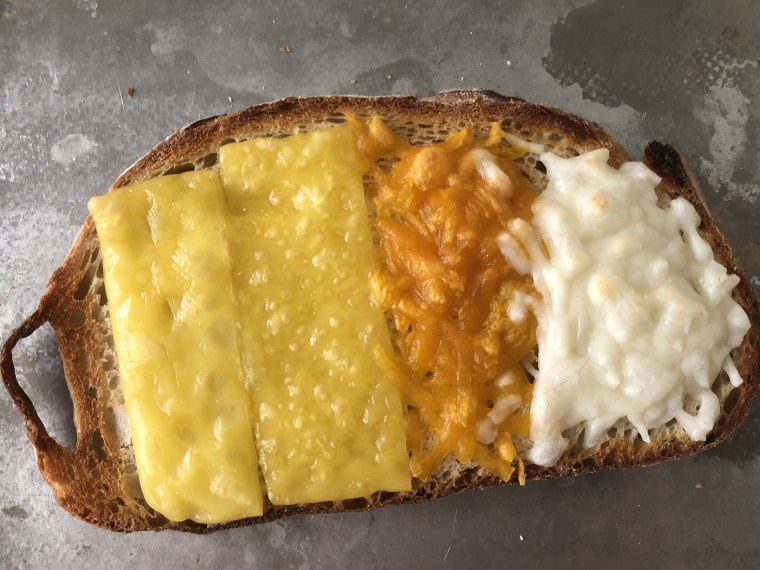
With all that cow’s milk has going for it, it’s no wonder the first dairy-free cheeses were a crime against nature: stiff, flavorless and highly melt-resistant. The second generation were based on coconut oil and little else, so they melted, but with an unappetizing ooze and meager flavor. When I occasionally made a dairy-free pizza over the years, I usually skipped the cheese entirely rather than suffer a slice with the texture of stale gum, or pools of tepid goo.
Today’s dairy-free cheese market has made real strides in texture and palatability, using all kinds of creative flavorings in addition to the usual yeast extract, like olive or citrus, but it’s nearly impossible to make a single product that will slice, crumble, melt, brown and taste like the real thing. Which ones manage it best? Let’s get to our ranking: the good, the bad and the shredded!
14. So Delicious Mozzarella-Style Shreds
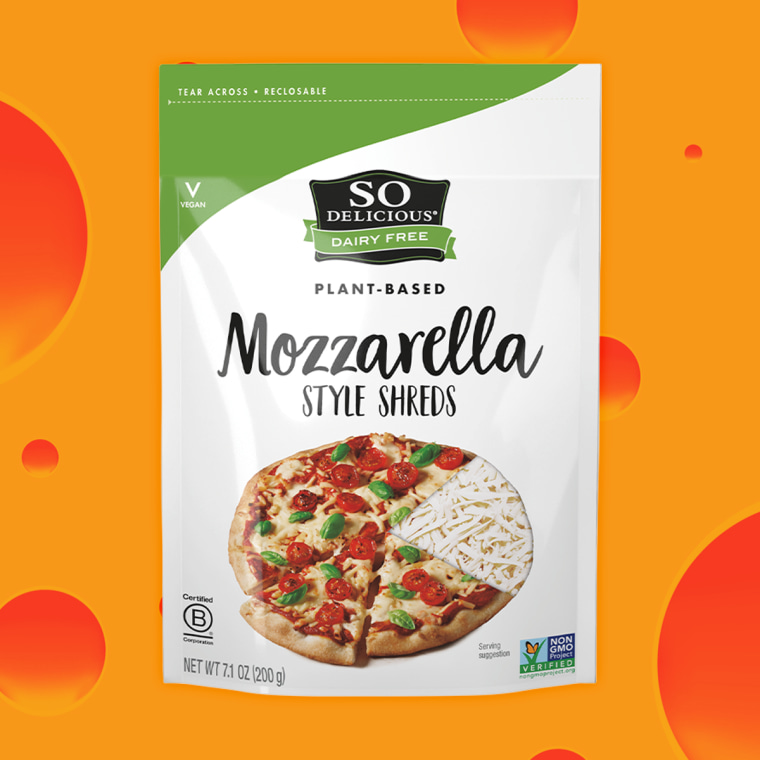
This brand makes some excellent ice creams, but its shredded cheese has the texture of packing peanuts when cold, and when hot, it has the texture of hot packing peanuts. It doesn’t melt well at all despite its coconut oil base. It also has a strange sweet flavor, perhaps from the fermented sugar used as a preservative, and it’s not fortified with vitamins or minerals. It’s easy to find, though, and a little less expensive than some other brands.
13. Annie’s Vegan Mac
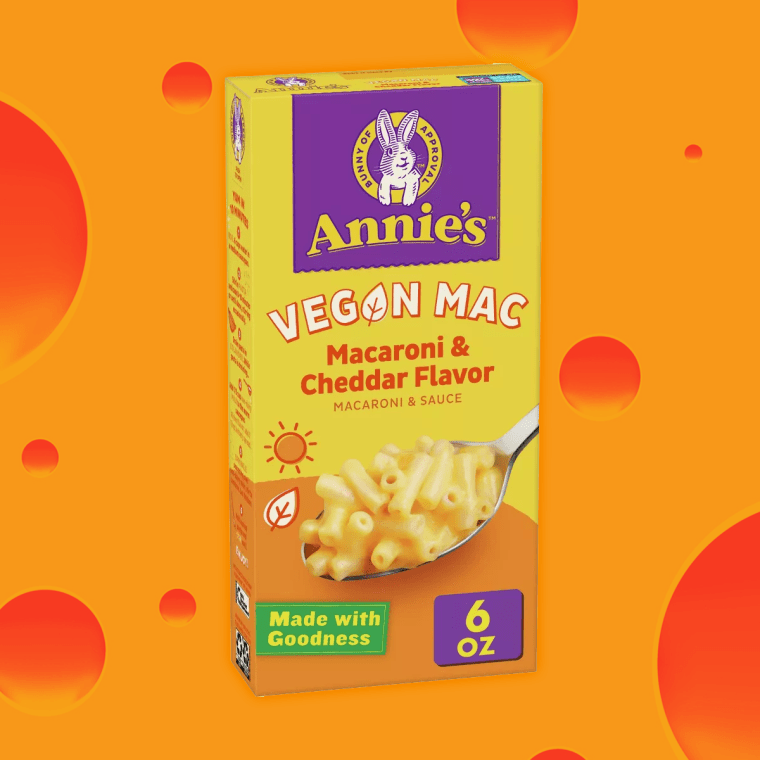
Annie’s makes several great products and often has led the industry in allergen-friendly versions of frozen and boxed meals. This is certainly the most convenient of the bunch in terms of offering up a whole entree with very little effort, but the flavor leaves something to be desired, relying mostly on salt. The yeast extract doesn’t have much in the way of other flavors to round it out, and to make sure it coats properly, it's given it the texture of hair gel — salty, salty hair gel. Its powdered cheese mac is a little bit better, but if you’re looking for that “blue box” taste, keep looking.
12. Daiya Cheddar-Style Shreds
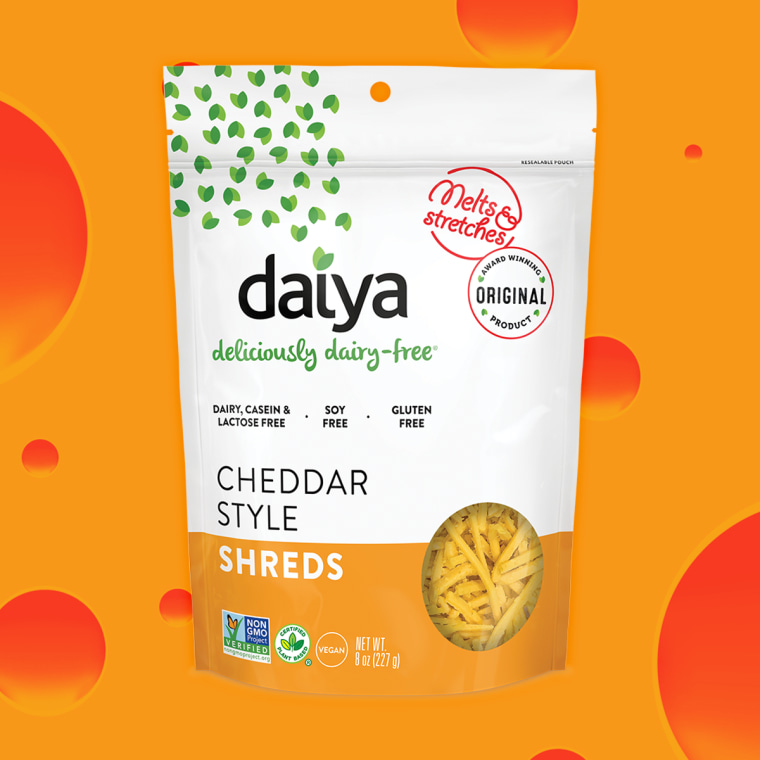
Daiya admittedly melts very smoothly, but it’s smooth to a fault. It's got a school glue texture, and the flavor is too mild to be truly evocative of cheese. It’s widely available, though, and its new formulation is a little bit better in flavor and texture than it used to be. This brand also led the pack in terms of frozen and boxed meals, like macaroni and cheese or pizza, and Daiya’s whole product line is free of other top-eight allergens, such as cashew or soy. It fortifies its coconut oil and potato starch mixture with calcium.
11. Tofutti Better Than Cream Cheese
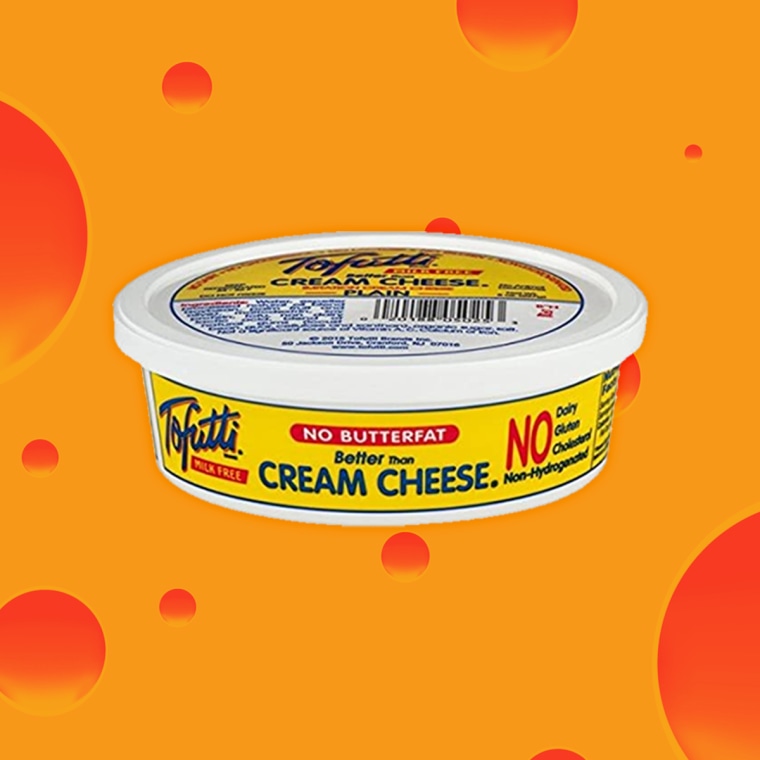
I have a lot of respect for this groundbreaking brand made from palm oil and non-GMO tofu, but Toffutti Better Than Cream Cheese ... isn’t. It has a chalky mouthfeel, an oddly flat flavor and doesn’t spread as well as some others. Despite the soy, it offers only a single gram of protein per serving. Its main claim to fame is that it’s stable for baking, but though it’s passable as a minor ingredient or with spicy and strong flavors added, I wouldn’t make it the star of your plate.
10. Treeline Dairy-Free French-Style Cheese
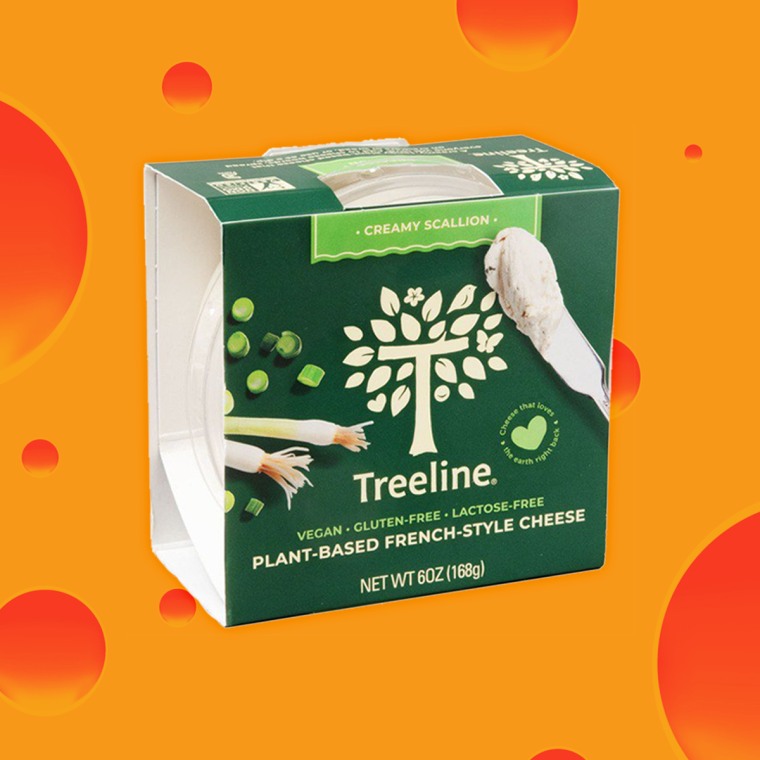
Cashew-based Treeline has a broad variety of vegan cheeses, and it's one of only a couple producing a French-style spreadable cheese. It spreads beautifully, and unlike most other dairy-free cheeses, it has almost half the protein of peanut butter. Unfortunately, the foundation flavor of lemon juice results in a sour nip rather than a balanced tang. If you hate goat cheese, you’re going to hate this. If you love goat cheese ... well, you still might hate this. I’ve used it instead of a mayo-mustard combo on a roasted vegetable sandwich, though, and it sings.
9. Good Foods Spicy Queso Blanco Style Dip

I really appreciate the effort here to make something relatively healthy, but it’s the spicy flavors that I find really refreshing. The main ingredient is cauliflower, with other ingredients like peppers, cashews and almonds. It’s much lower-calorie than anything else on this list, but it’s still super creamy and feels indulgent on tortilla chips or tacos. Is it cheesy though? The effect is more like sour cream sauce or ranch dressing than queso. I love it, I love the ingredients, but it doesn’t quite ring true. Still, you can bake it into enchiladas, quiches and casseroles without it splitting, which is a major win.
8. Parmela Creamery Sharp Cheddar Shreds
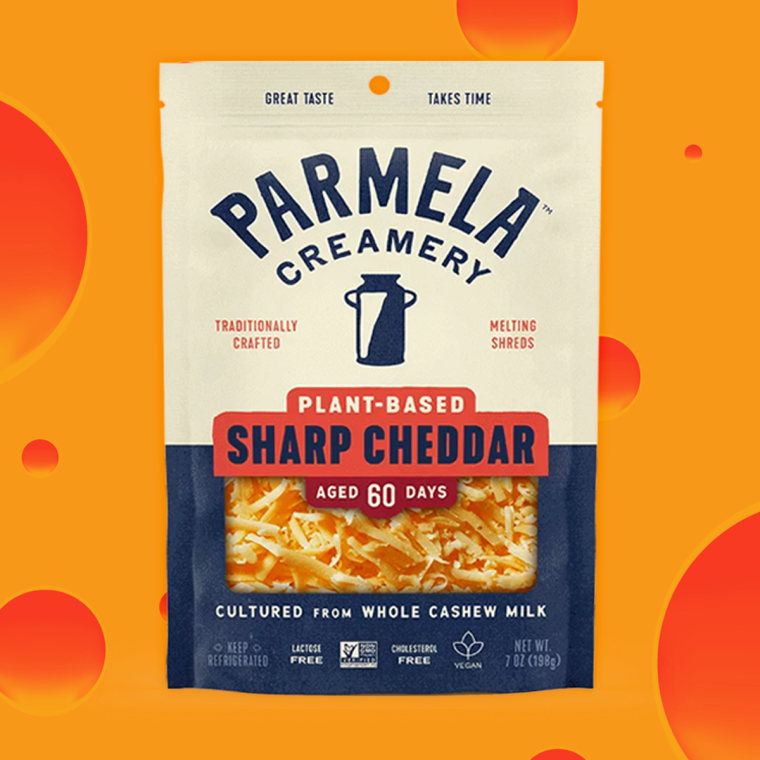
This brand’s shreds have a soft texture similar to processed American cheese, but melted in the microwave, it turns to a sort of greasy jelly, like apricot jam mixed with cooking oil. It fares a bit better toasted in dry heat, but the layer underneath remains sticky. In general, cashews work better than anything else to replace the mouthfeel of dairy, and Parmela has done something interesting here using prolonged aging, but with real cheese, the fermented and savory flavors are up high, noticeable as soon as you taste. With this one, the almost believable funk down low doesn’t quite make up for the bland, featureless beginning. They have very little nutritional value, sadly, but extra marks for having a spicy Jack flavor.
7. Field Roast Creamy Original Chao Slices
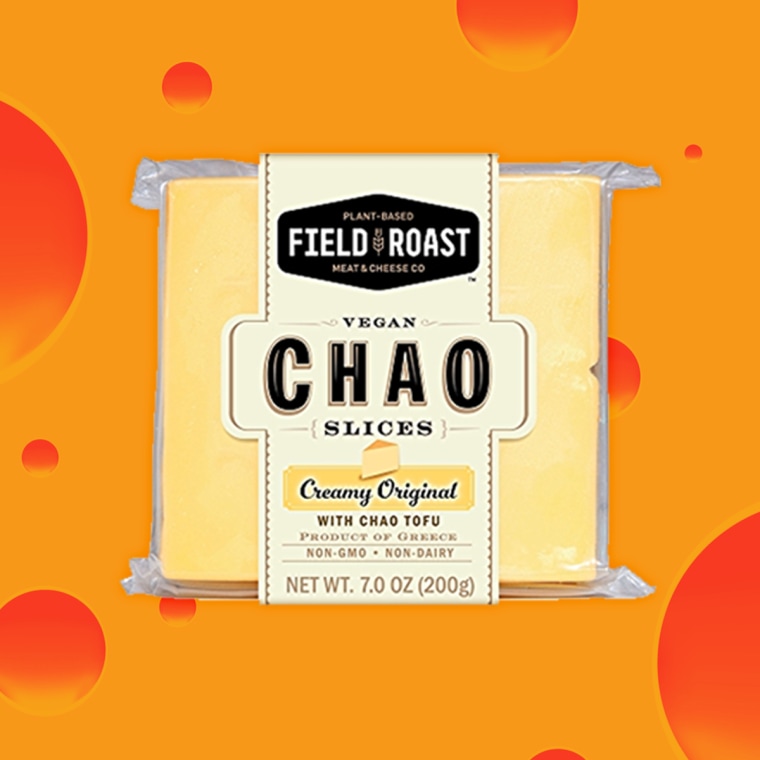
Field Roast uses fermented soybeans along with coconut in its Chao Slices, so they have a little bit more of an umami bite than some of the others, but they also have olive extract in a creative attempt to mimic cheesy tang. The original flavor is pretty mild, but the olive gives it a faint musty aftertaste. It’s not noticeable when eaten along with something else, though, and it does keep it from tasting flat. The slices are more brittle than real cheese, but it’s a stiffness that gives it the resistance that’s important on a cold sandwich. Melted, it doesn’t fare much better than Parmela Creamery — an oily mess in the microwave, melted plastic wrap in the toaster oven. Again, it’s largely devoid of nutritional value.
6. Follow Your Heart Finely Shredded Mozzarella
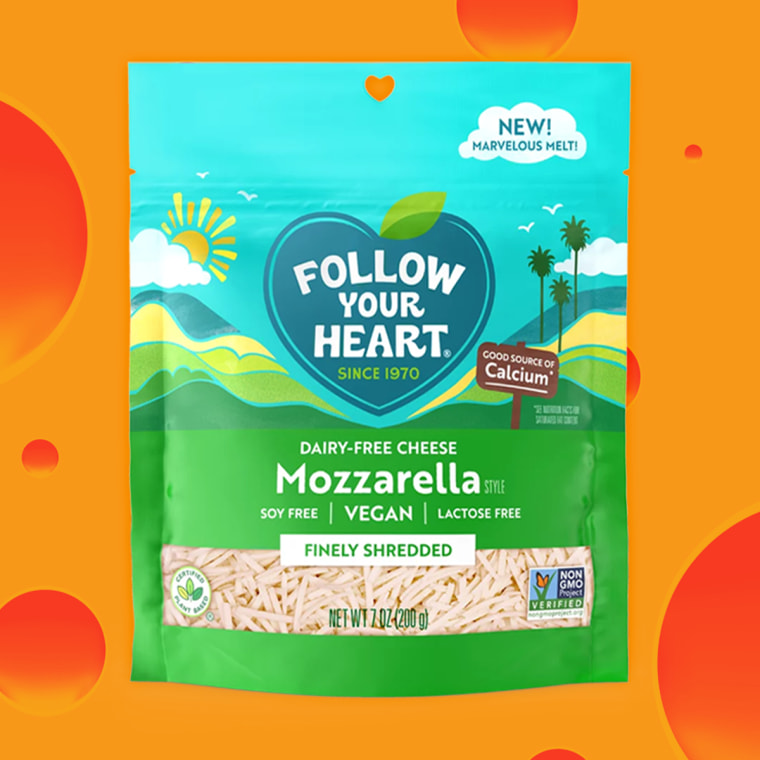
Although based on coconut like most other modern plant-based cheeses, this one does not turn into a slick pool to the degree that the other similar formulae do. It melts well if you give it long enough and retains some opaqueness. It will stretch a bit, but doesn’t have the bounce of real cheese. Instead it’s a bit sticky, and it adheres to your teeth. If you’ve ever had St. Louis-style pizza with processed provel cheese, you’ll be familiar with the texture. That’s actually a compliment — this brand is one of the closer ones in terms of appearance and texture to real melted cheese, or at least processed cheese. It works pretty well when sprinkled on something hot, like sauteed broccoli or a baked potato, rather than really melted so that some of the not-quite-right background flavors come to the forefront. That said, I prefer this brand to most others for melting into sauces, too.
The flavor? It’s fine. You’ll never mistake it for real mozzarella, but it’s miles better from the earliest attempts at dairy-free cheese in the '90s. Cold shreds on a salad aren’t bad at all.
5. Babybel Plant-Based Cheese Alternative

They’ve certainly replicated the fun of peeling off the wax coating on a regular Babybel. The texture is much better than these products used to be, more sturdy, less gelled, but it’s still softer than most aged cheeses. If you like mild cheeses, this might be a favorite, but if you’re looking for the usual Babybel flavor, you’ll be disappointed. The common problematic coconut oil mouth-coating effect is thankfully absent. They contain little protein, but they’ve added some calcium and B12, and the flavor and texture rounds out a snack of fresh fruit or crackers very well.
4. Kite Hill Dairy-Free Chive Cream Cheese
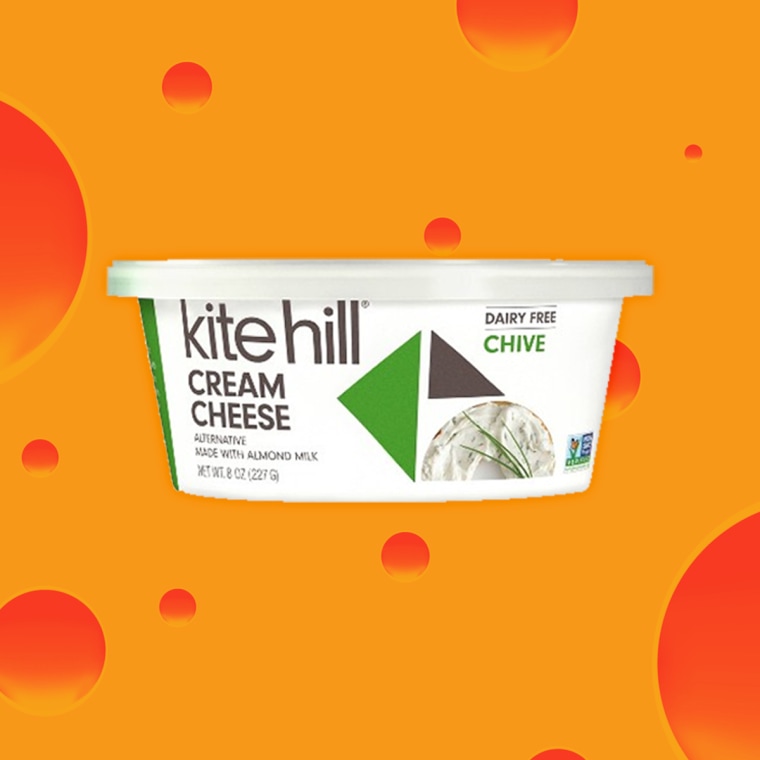
This brand is one of the few to start with almonds. It makes ricotta and cream cheese, but nothing sliced or shredded. For those soft cheeses, though, it’s one of the best. This one with chives has a very credible tang that could actually be mistaken for the real thing, and it even has as much protein as dairy cream cheese. It benefits from a little stirring before spreading. I use cream cheese as a substitute for heavy cream in sauces and soups a lot, and this one works for that if you whisk really well and are OK with a few particle-sized lumps. Kite Hill also makes very good fresh pastas filled with its almond ricotta. If you’re going dairy-free for sustainability reasons, though, remember that products based on almonds often use a lot of water to produce.
3. Violife Smoked Provolone Slices
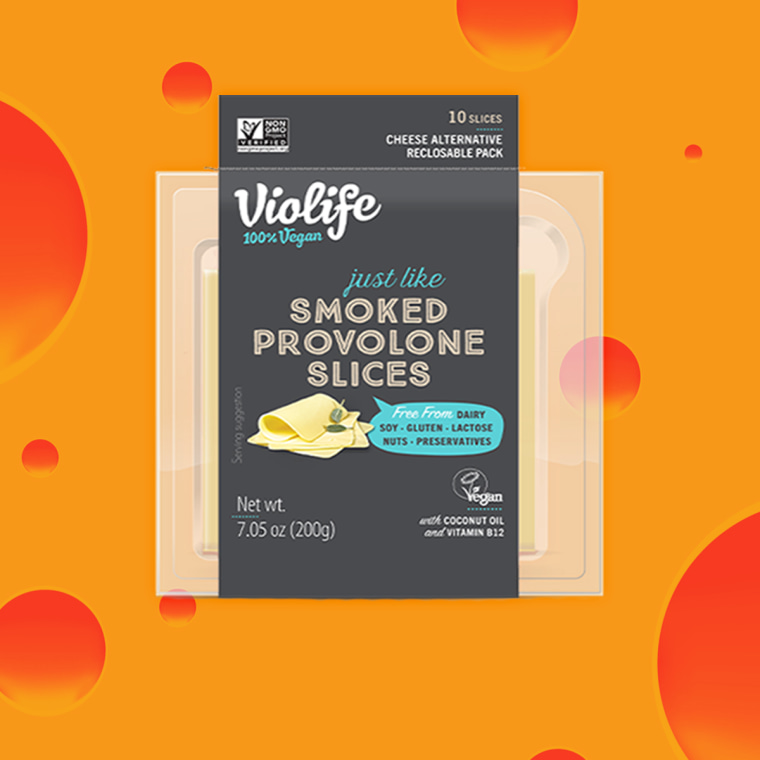
If you’re looking for a slice with a sturdy bite and a creamy mouthfeel for a cold sandwich, this brand can’t be beat. The Smoked Provolone is particularly successful in terms of replicating the flavor of cheese. Sadly, try to use it in other recipes, and it reveals itself to be a dairy-free Jekyll and Hyde. Melted, it dissolves into a squishy puddle, as though someone left the butter dish too close to the radiator. It does melt into sauce, but it’s going to be an oily sauce if you don’t stabilize it with flour or starch. It offers no resistance to the bite when melted on toast or in a quesadilla. This brand is one of the few that adds a little B12 fortification, though.
2. Miyoko’s Creamery Organic Liquid Vegan Pizza Mozzarella
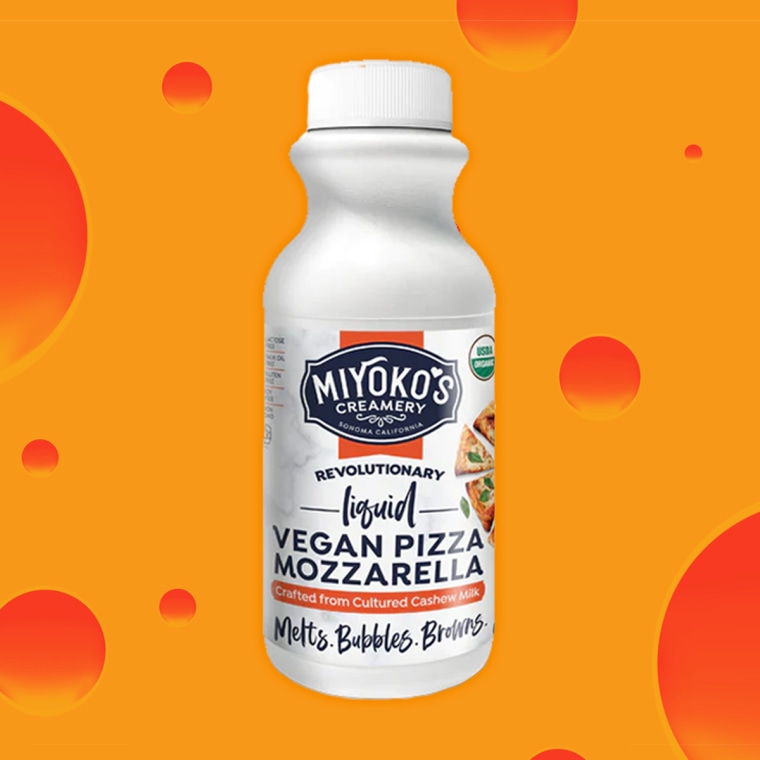
This brand uses cashews as its base ingredient, largely to superior effect. A lot of pizzerias use its liquid pizza cheese for vegan or dairy-free customers. It sounds like a terrible idea: You ... pour ... the cheese ... on the crust?
But, as it bakes, the texture is transformed. Because of the little bit of protein from the cashews, it even browns a bit. Here’s one before and after baking at 475 F for 10 minutes. As it heats, it dries and stiffens, and turns a bit strangely translucent, but it doesn’t suffer from the gumminess factor.
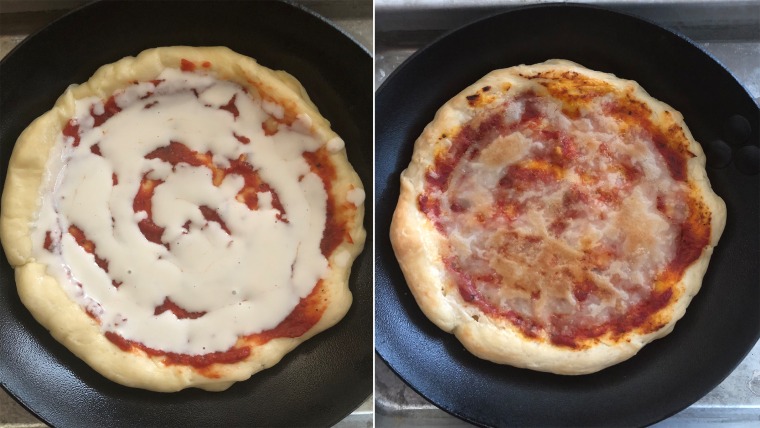
It tastes like somewhat processed cheese, but given the competition, that’s not bad. Baker beware, though — you must be very careful about the amount you pour on your pizza, because if it doesn’t heat to at least 165 F, it will remain liquid. Its directions call for just 1/4 cup for a 10-inch pizza, and if you’re making a larger or smaller one, you’ll need to remember that the area of a circle is not in direct correlation with the diameter. While a 10-inch pizza has an area of about 314 square inches, a 5-inch has just a quarter of that, so you would only use a tablespoon. A 15-inch is more than double, requiring over half a cup. Measure it out a couple of times, though, and you’ll be able to eyeball it next time. I find it works best to drizzle on with a spoon and then spread just a bit to keep from blending with the sauce.
As for nutrition, it has a couple of grams of protein per quarter cup, but the same amount of mozzarella has about eight, and you’re never going to get that extra cheesy, stretchy goodness out of this product. Still, it’s one of the more convincing of the lot.
1. Moocho Dairy-Free Mozzarella Style Shreds
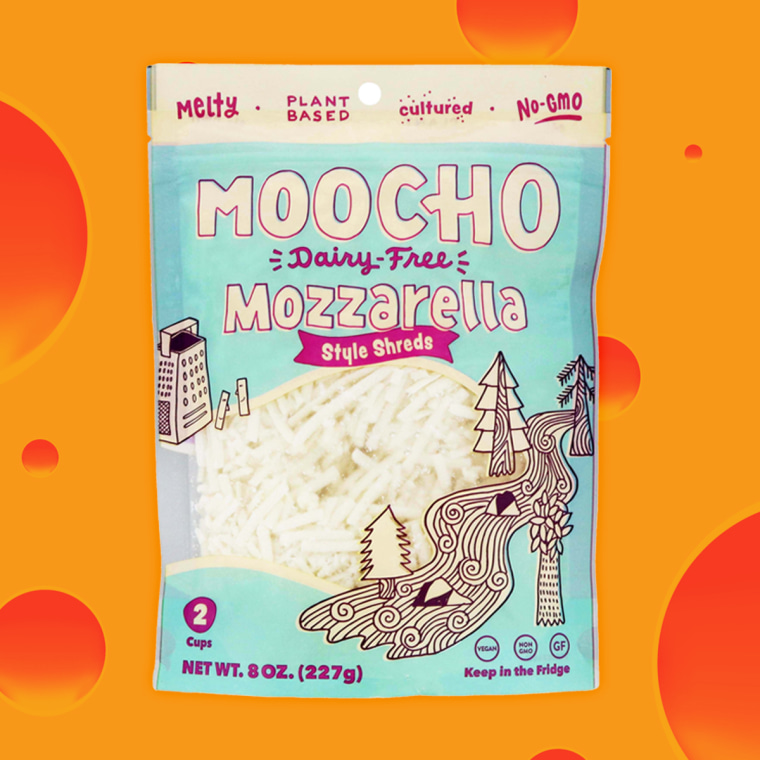
The winner? It’s a newcomer to the market, Moocho, brought to you by the Tofurky people. Like many other brands, it’s based on coconut and a couple of different food starches, but it adds fava bean protein. Maybe that’s responsible for its resistance to translucency and disintegration into jelly. It doesn’t melt exactly the way dairy cheese does, but though it’s hard to tell from this photo, it did meld into a continuous topping when I gave it long enough, and the melted mouthfeel is the closest to real cheese of anything I’ve ever tried. You can encourage melting by microwaving no more than 10 to 15 seconds before putting it into the oven.
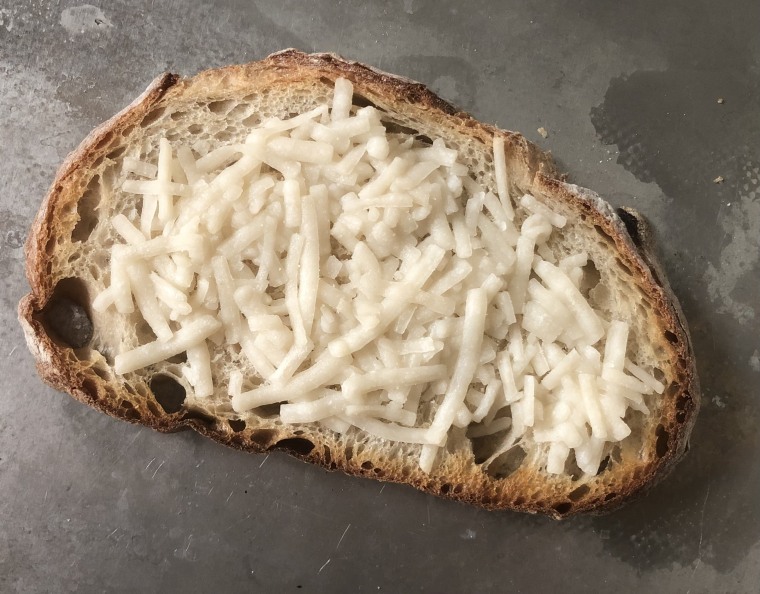
All of the shredded cheeses have a powdery mouthfeel from the starch added to prevent clumping, and this one is no exception, but when melted, it’s a lot less tooth-sticking than the others, and the flavor has a more balanced complexity without being overwhelmingly salty or sour. It’s not as elastic or nutritious as real cheese, but after trying dozens of miserable dairy-free versions over the last decade, I’m shocked at how good this one is. It's only recently started appearing in major grocery chains, so if you don’t see it near you yet, try your local natural foods market.
The upshot? If you’ve been dairy-free for a long time and were disappointed with plant-based cheese years ago, give the new ones a try. They’ve made some great strides. But if you’re new to dairy-free and had a large extra cheese pie last week, only a couple of these might fool you, and even then probably only in certain contexts.
Here are a few tips for successful substitution:
- Try to think of these products as their own thing rather than an exact replica.
- Don’t assume that they’re providing much protein, calcium or vitamins, and make sure you’re getting those nutrients elsewhere.
- Read directions carefully, and until you get the hang of dairy-free cooking, use recipes from the brand you’ve chosen — one brand’s melt method is another brand’s burn, and only a few products are stable at boiling or extended baking temperatures.
- Think about other ingredients in the recipe you’re using to balance out sourness or add umami.
- Once you find a handful of products whose characteristics you like best, consider combining them for the best effect — taste of one with texture of another — but be forewarned that sometimes mixing cheeses that use different base ingredients can bring out “off” flavors that you didn’t notice when they were tasted alone.
None of these are a perfect copy of all of the characteristics of cheese, but the feature you crave most is available from some product, somewhere. If you keep your sense of humor (and a backup meal) handy in case of disaster, you’ll find ways to keep your meals and snacks familiar and interesting but still in line with your needs. That’s the most important thing, any way you slice it.